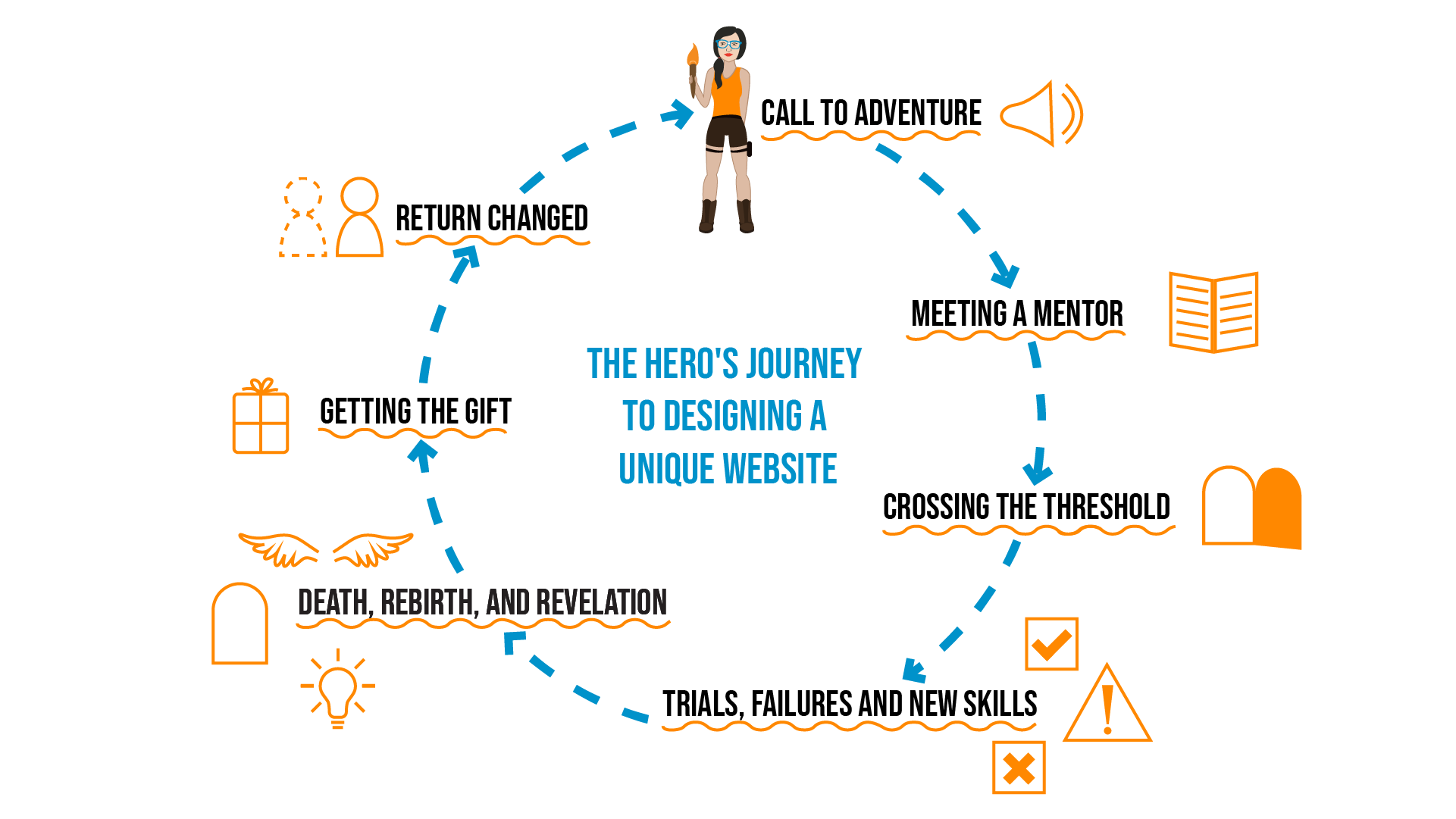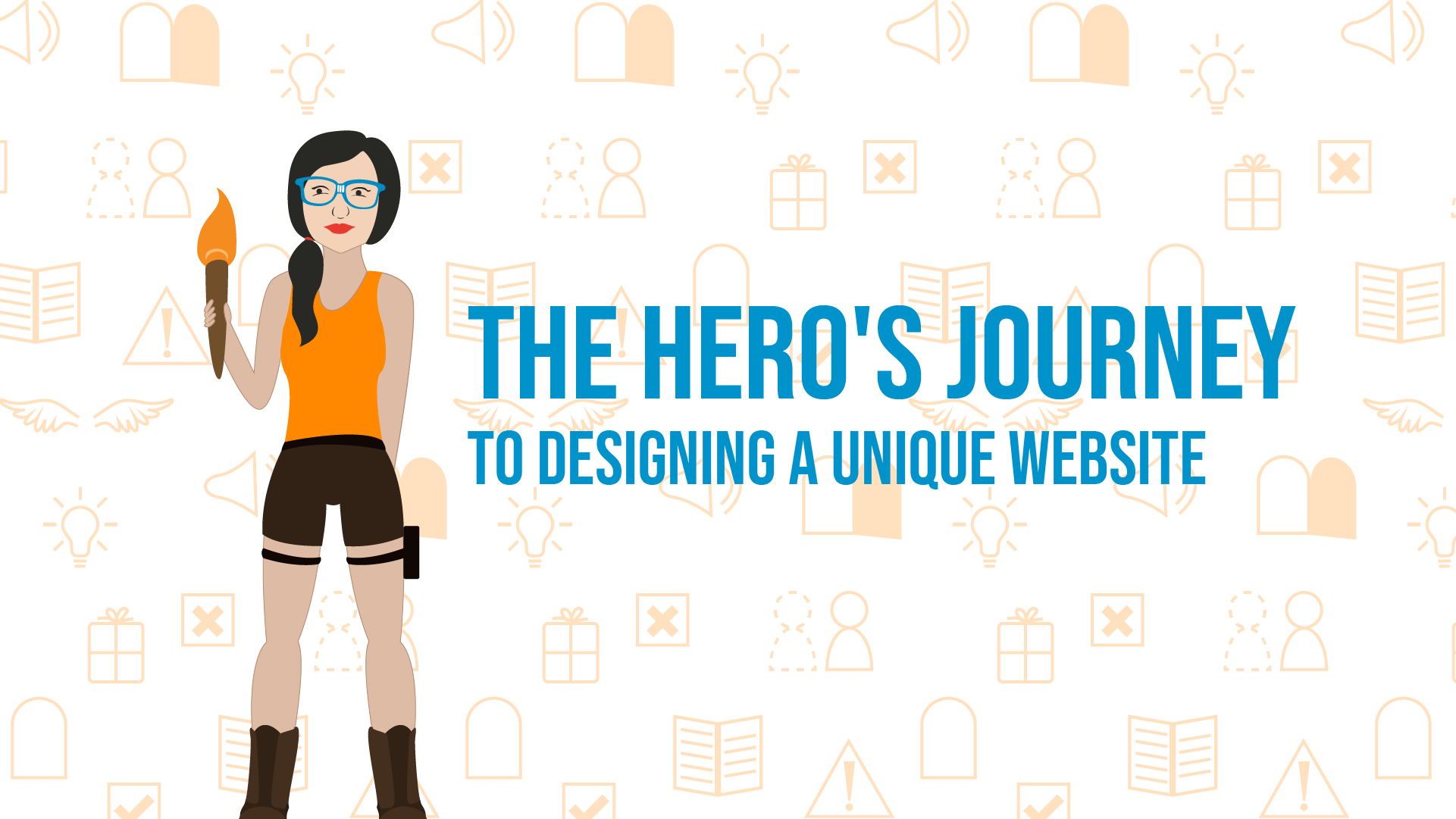The Hero's Journey to Designing a Unique Website
Posted on October 04, 2024 nerdymind
Here you are, the hero answering the call to adventure. You may not be a hobbit who was just given his uncle's ring by a wizard, or a Jedi receiving a mysterious message from your long lost sister, but your quest is just as valiant: designing a unique website.

The Call to Adventure
In the vast and never-ending digital world, creating and designing a unique website can be daunting. Your website often forms the first impression people have of your business. It’s your brand’s front door and the hub of your online presence. Getting started is hard, but like any brave hero you must be willing to face the challenges ahead.
Meeting a Mentor
At NerdyMind, we know that web design is more than just aesthetics—it’s about creating an engaging, seamless, and functional experience to connect with your audience. We are your mentor on this quest, the old wizard guiding you along. Whether you're reading this blog or looking to us to help build your website, we are here for you through every step of the process.

Crossing the Threshold
Before you set off on your quest, you need some tools. At the heart of great web design is the user experience (UX). It’s not enough to have a beautiful website if visitors struggle to navigate or find the information they need. That’s why a user-centered approach is essential when designing any site. This involves:
Research: Understand your target audience. What are their needs? What motivates them?
Mapping User Journeys: From the homepage to the checkout process or contact forms, every interaction should feel intuitive.
Feedback Loops: Incorporate user testing and gather feedback regularly to refine the experience.
As your magical mentor, NerdyMind emphasizes designing with empathy. You want to ensure your website solves problems and answers questions with ease. Now that you have your starting tools and your companions, you're ready to set off into the unknown.
Trials and Failure & New Skills
Designing websites, much like any quest, involves a journey filled with both trials and failures. It’s easy to think of web design as a linear process—moving from concept to completion without hiccups—but the reality is far more iterative. Every successful website is built on a foundation of trial, error, and learning from mistakes.
The First Draft Is Rarely Perfect
Every project begins with a vision, but translating that vision into a functional website can be tricky. What seems ideal in theory may fall flat in practice. You might design a beautiful homepage, but users find it cluttered. Or a slick navigation bar might confuse visitors instead of guiding them. The truth is, the first draft of any website is rarely perfect.
The Quest for Perfection Leads to Delays
Another trial in website design is the temptation to chase perfection. It’s easy to get lost in the details—obsessing over minor design elements, tweaking every pixel until a page feels just right. But in many cases, this leads to delays, endless revisions, and burnout.
Sometimes, the fear of failure keeps designers from launching a site that isn’t "perfect" in their eyes. But perfection is an illusion in the fast-paced world of web design. Websites are meant to evolve, and learning to embrace imperfection—and adapt over time—is one of the hardest, yet most valuable lessons in design.
Overlooking Performance in Favor of Design
One of the common missteps in web design is prioritizing visual elements over performance. A website filled with high-resolution images, complex animations, and heavy scripts might look impressive, but slow load speeds will likely turn users away. Failure to consider the technical side of web development often results in a visually rich site that frustrates users due to long load times, unresponsive elements, or bugs. This is a trial many web designers face—how to create a visually stunning site that also performs well.
Through the trials and failures, you'll come out of it with new skills that will further you on your quest to design a unique website.
Death, Rebirth, and Revelation
Designing a unique website often mirrors the cycle of death and rebirth. Every website will eventually face a moment when it must "die" to make way for something better—a rebirth that brings new life to the brand. As the hero you may not like this, but it's a stage of the hero's journey that you must face with bravery.
Death
Death can mean a few different things: death of an old website, death of an idea, or death of a mock-up. No matter your website's demise, the reasons are often similar:
Outdated Design: Trends in web design move fast. A website that looked cutting-edge five years ago may now feel stale or unprofessional. Mobile could also be the killer; lack of responsiveness for mobile devices is often a glaring issue.
Poor Performance: Slow load times, broken links, and compatibility issues are the equivalent of a website losing its vitality. These issues create frustration for users and diminish your SEO rankings, making the site harder to find and less engaging.
Shifting Brand Identity: As businesses grow and pivot, their brand identity and messaging often change. An old website might no longer reflect the current vision, values, or services of a business, which can lead to a disconnect between the website and its visitors.
Evolving User Expectations: User behavior and expectations change over time. Features that were once considered luxuries, like personalized content or intuitive navigation, have now become baseline expectations. If a website doesn’t keep up with these shifts, it risks losing relevance.
Recognizing the death of a website can be difficult—especially when there’s emotional attachment to it or fear of letting go. As the hero, you must accept this fact. Understanding that this end paves the way for a more modern and functional rebirth is the first step.
Rebirth
Rebirth is a complete renewal that brings the site into alignment with the latest technology, user needs, and business goals. A website rebirth involves taking the best lessons from the past and using them to create something stronger, more vibrant, and more effective. The best part of rebirth is that you can choose what it looks like:
Reimagining the User Experience: The rebirth of a website should start with a focus on the user experience (UX). Through user research, data analysis, and testing, designers and developers can create a new layout that makes navigation easier, loads faster, and provides users with exactly what they’re looking for. It’s a chance to rethink everything, from page flow to how users interact with elements like forms or menus.
Revitalizing Visual Design: Visual design is one of the most immediate ways to breathe new life into a website. A reborn site features fresh design trends, modern layouts, and brand-aligned aesthetics that make a bold statement.
Incorporating the Latest Technology: Technology moves fast, and a website rebirth is the perfect opportunity to integrate new tools and systems. It's like transforming from Gandalf the Grey to Gandalf the White. This includes adopting responsive design, speed optimization, enhanced security, and SEO best practices.
Fostering Flexibility for the Future: A reborn website should be built with flexibility in mind. One of the biggest lessons learned from the “death” of an old site is that change is inevitable. By adopting a modular design, integrating a content management system (CMS), and using scalable technology, businesses can easily evolve their site without the need for another complete overhaul in a few years.

As your mentor, NerdyMind encourages you to embrace this cycle of death and rebirth. A website rebirth isn’t a failure—it’s an opportunity to refine, refresh, and grow. This, as the hero, should be your revelation. When a website has reached the end of its useful life, it’s not about hanging onto the past. It's about building something better for the future.
Getting the Gift
The hard part of your quest is over, and for your hardship you'll be rewarded. After designing a unique website, you'll receive the ultimate prize: conversions.
Form Completions: Whether it’s a newsletter signup or a contact form, if users are submitting their information, the design is doing its job to guide them toward action.
E-commerce Sales: For online stores, successful design can be measured by how effectively it drives product sales. A simplified checkout process, appealing product pages, and prominent calls-to-action all contribute to boosting sales.
Lead Generation: In service-based businesses, a design that increases inquiry submissions or consultation requests indicates success.
Returned Changed
You, dear hero, have reached the end of your quest. You have designed a unique website. You return home, glorious and victorious with your conversions in hand. You may look the same, but your website has changed for the better. Celebrations are plenty, feasts are held in your honor. Let's just hope there isn't a sequel.
Need a little help on your own adventure? NerdyMind is your magical mentor. Contact us today to design a unique website that attracts and gains local customers.

